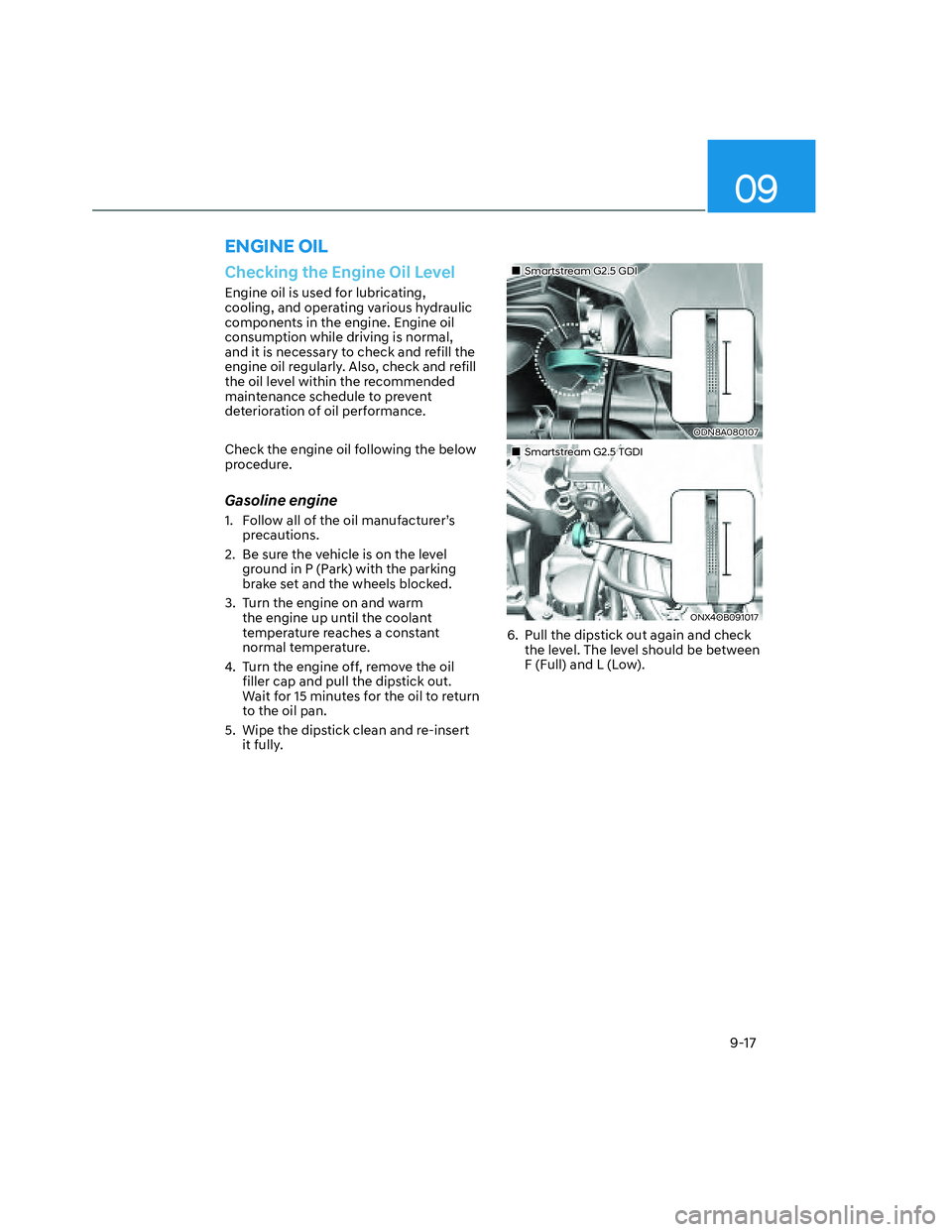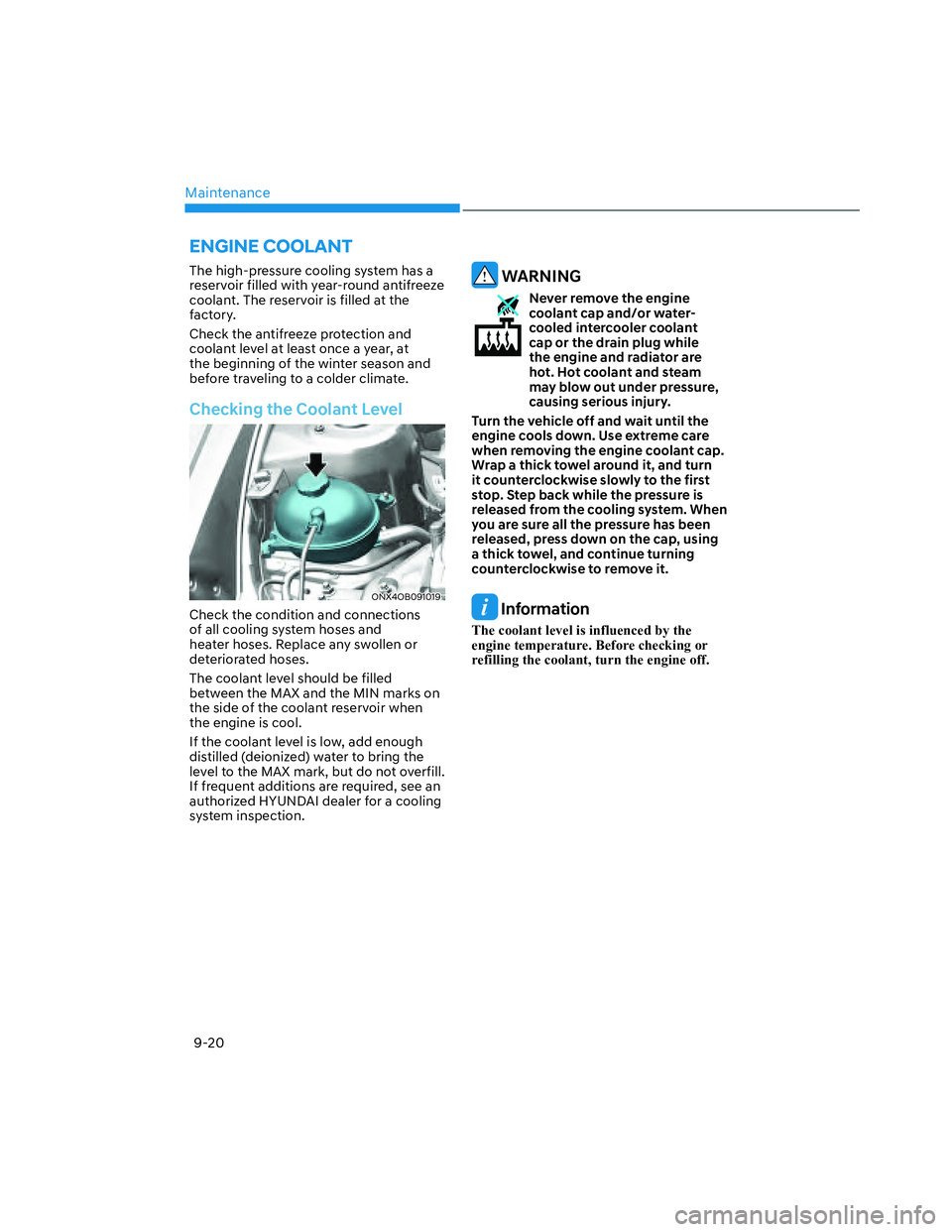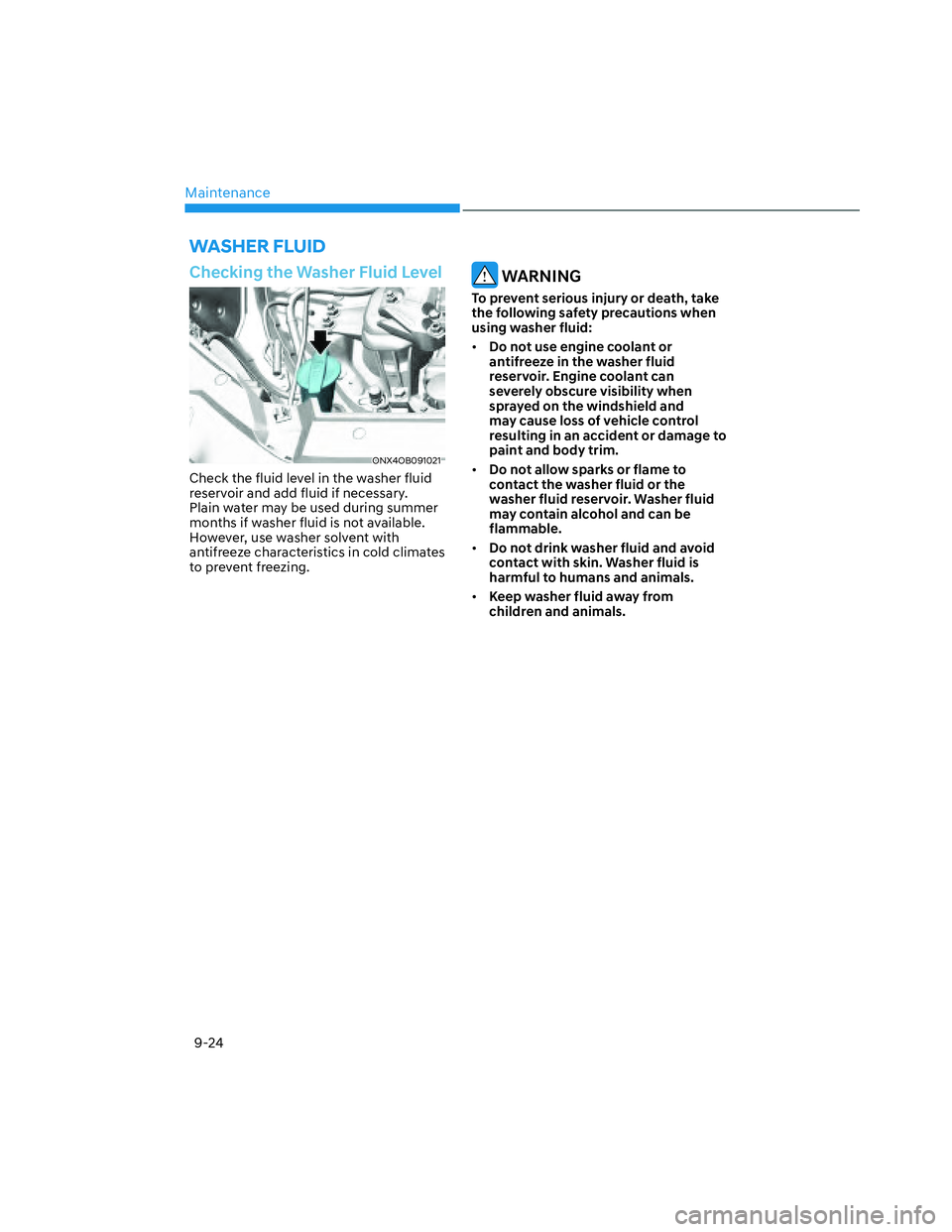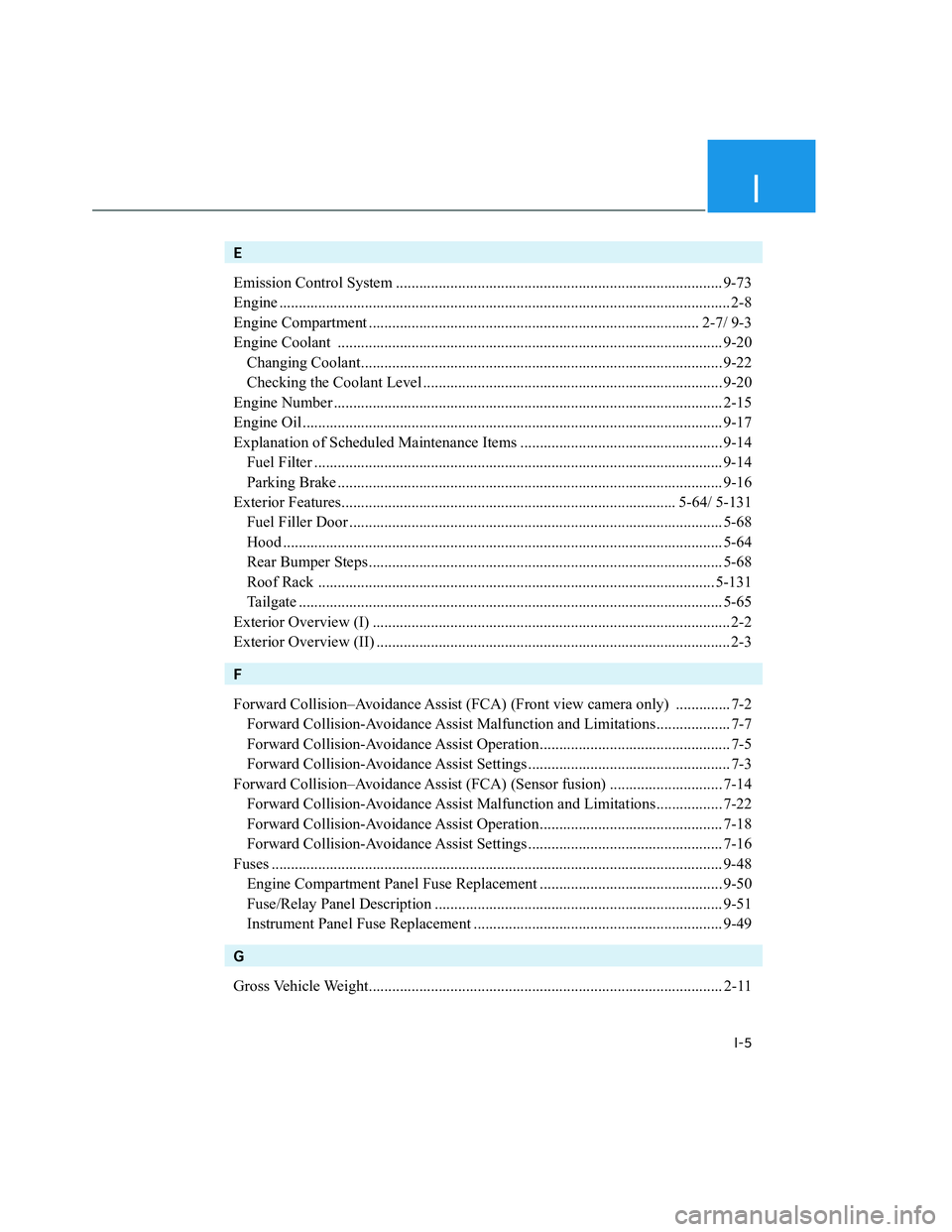Page 525 of 598

09
9-17
ENGINE OIL
Checking the Engine Oil Level
Engine oil is used for lubricating,
cooling, and operating various hydraulic
components in the engine. Engine oil
consumption while driving is normal,
and it is necessary to check and refill the
engine oil regularly. Also, check and refill
the oil level within the recommended
maintenance schedule to prevent
deterioration of oil performance.
Check the engine oil following the below
procedure.
Gasoline engine
1. Follow all of the oil manufacturer’s
precautions.
2. Be sure the vehicle is on the level
ground in P (Park) with the parking
brake set and the wheels blocked.
3. Turn the engine on and warm
the engine up until the coolant
temperature reaches a constant
normal temperature.
4. Turn the engine off, remove the oil
filler cap and pull the dipstick out.
Wait for 15 minutes for the oil to return
to the oil pan.
5. Wipe the dipstick clean and re-insert
it fully.
�����„�„Smartstream G2.5 GDISmartstream G2.5 GDI
ODN8A080107ODN8A080107
�����„�„Smartstream G2.5 TGDISmartstream G2.5 TGDI
ONX4OB091017ONX4OB091017
6. Pull the dipstick out again and check
the level. The level should be between
F (Full) and L (Low).
Page 528 of 598

Maintenance
9-20
ENGINE COOLANT
The high-pressure cooling system has a
reservoir filled with year-round antifreeze
coolant. The reservoir is filled at the
factory.
Check the antifreeze protection and
coolant level at least once a year, at
the beginning of the winter season and
before traveling to a colder climate.
Checking the Coolant Level
ONX4OB091019ONX4OB091019
Check the condition and connections
of all cooling system hoses and
heater hoses. Replace any swollen or
deteriorated hoses.
The coolant level should be filled
between the MAX and the MIN marks on
the side of the coolant reservoir when
the engine is cool.
If the coolant level is low, add enough
distilled (deionized) water to bring the
level to the MAX mark, but do not overfill.
If frequent additions are required, see an
authorized HYUNDAI dealer for a cooling
system inspection.
WARNING
Never remove the engine
coolant cap and/or water-
cooled intercooler coolant
cap or the drain plug while
the engine and radiator are
hot. Hot coolant and steam
may blow out under pressure,
causing serious injury.
Turn the vehicle off and wait until the
engine cools down. Use extreme care
when removing the engine coolant cap.
Wrap a thick towel around it, and turn
it counterclockwise slowly to the first
stop. Step back while the pressure is
released from the cooling system. When
you are sure all the pressure has been
released, press down on the cap, using
a thick towel, and continue turning
counterclockwise to remove it.
Information
The coolant level is influenced by the
engine temperature. Before checking or
refilling the coolant, turn the engine off.
Page 532 of 598

Maintenance
9-24
WASHER FLUID
Checking the Washer Fluid Level
ONX4OB091021ONX4OB091021
Check the fluid level in the washer fluid
reservoir and add fluid if necessary.
Plain water may be used during summer
months if washer fluid is not available.
However, use washer solvent with
antifreeze characteristics in cold climates
to prevent freezing.
WARNING
To prevent serious injury or death, take
the following safety precautions when
using washer fluid:
• Do not use engine coolant or
antifreeze in the washer fluid
reservoir. Engine coolant can
severely obscure visibility when
sprayed on the windshield and
may cause loss of vehicle control
resulting in an accident or damage to
paint and body trim.
• Do not allow sparks or flame to
contact the washer fluid or the
washer fluid reservoir. Washer fluid
may contain alcohol and can be
flammable.
• Do not drink washer fluid and avoid
contact with skin. Washer fluid is
harmful to humans and animals.
• Keep washer fluid away from
children and animals.
Page 589 of 598

I
I-5
E
Emission Control System .................................................................................... 9-73
Engine .................................................................................................................... 2-8
Engine Compartment ..................................................................................... 2-7/ 9-3
Engine Coolant ................................................................................................... 9-20
Changing Coolant............................................................................................. 9-22
Checking the Coolant Level ............................................................................. 9-20
Engine Number .................................................................................................... 2-15
Engine Oil ............................................................................................................ 9-17
Explanation of Scheduled Maintenance Items .................................................... 9-14
Fuel Filter ......................................................................................................... 9-14
Parking Brake ................................................................................................... 9-16
Exterior Features...................................................................................... 5-64/ 5-131
Fuel Filler Door ................................................................................................ 5-68
Hood ................................................................................................................. 5-64
Rear Bumper Steps ........................................................................................... 5-68
Roof Rack ...................................................................................................... 5-131
Tailgate ............................................................................................................. 5-65
Exterior Overview (I) ............................................................................................ 2-2
Exterior Overview (II) ........................................................................................... 2-3
F
Forward Collision–Avoidance Assist (FCA) (Front view camera only) .............. 7-2
Forward Collision-Avoidance Assist Malfunction and Limitations................... 7-7
Forward Collision-Avoidance Assist Operation................................................. 7-5
Forward Collision-Avoidance Assist Settings .................................................... 7-3
Forward Collision–Avoidance Assist (FCA) (Sensor fusion) ............................. 7-14
Forward Collision-Avoidance Assist Malfunction and Limitations................. 7-22
Forward Collision-Avoidance Assist Operation............................................... 7-18
Forward Collision-Avoidance Assist Settings .................................................. 7-16
Fuses .................................................................................................................... 9-48
Engine Compartment Panel Fuse Replacement ............................................... 9-50
Fuse/Relay Panel Description .......................................................................... 9-51
Instrument Panel Fuse Replacement ................................................................ 9-49
G
Gross Vehicle Weight........................................................................................... 2-11